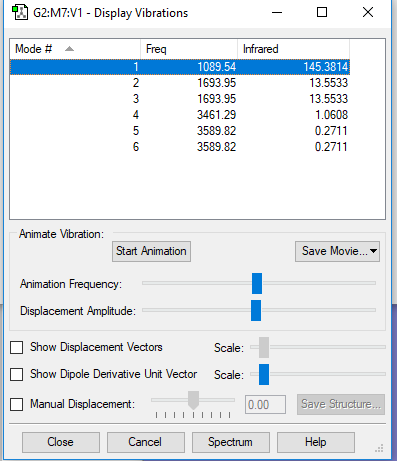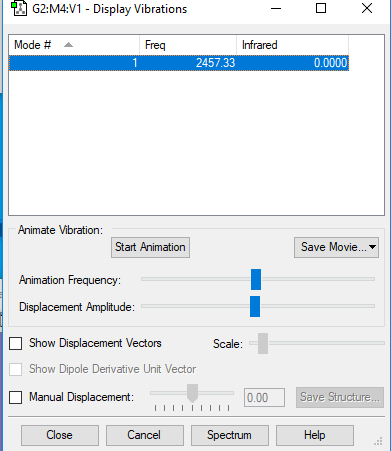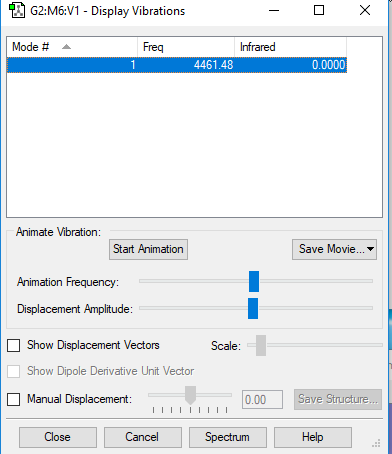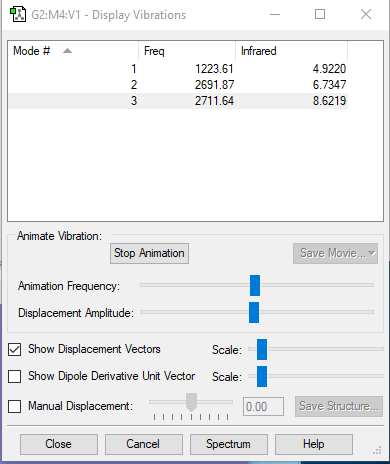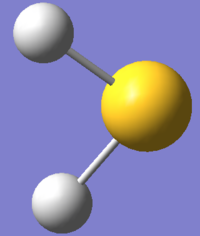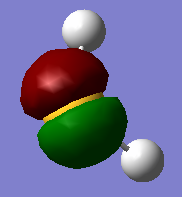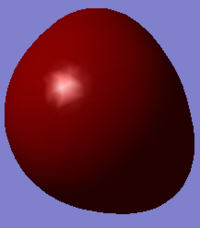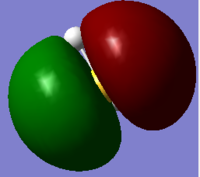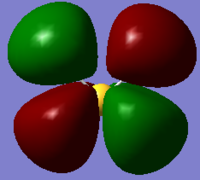Rep:Mod:01552413
NH3 Optimisation
| What is the molecule? | NH3 |
| What is the calculation method ? | RB3LYP |
| What is the basis set? | 6-31G(d,p) |
| What is the final energy E(RB3LYP) in atomic units (au)? | -56.55776873 |
| What is the RMS gradient? | 0.00000485 |
| What is the point group of your molecule? | C3V |
| What is the N-H bond distance in Armstrong? | 1.02 |
| What is the H-N-H angle (°) ? | 106 |
Item table of NH3
Item Value Threshold Converged? Maximum Force 0.000004 0.000450 YES RMS Force 0.000004 0.000300 YES Maximum Displacement 0.000072 0.001800 YES RMS Displacement 0.000035 0.001200 YES
Link to NH3 optimisation - https://wiki.ch.ic.ac.uk/wiki/images/e/e2/Sameer_Imran_N2_OPT.LOG
NH3_Molecule |
Vibrational analysis of NH3
| Wavenumber (cm-1) | 1090 | 1694 | 1694 | 3461 | 3590 | 3590 |
|---|---|---|---|---|---|---|
| Symmetry | A1 | E | E | A1 | E | E |
| Intensity (arbitrary units) | 145 | 14 | 14 | 1 | 0.3 | 0.3 |
| image |  |
 |
 |
 |
 |
 |
Structural analysis of NH3
| How many modes using 3N-6 rule? | 6 |
| which modes are degenerate? | 2 and 3, 5 and 6 |
| which modes are "bending" vibrations and which are "bond stretch" vibrations? | 1,2,3 are bending vibrations and 4,5,6 are stretching vibrations |
| which mode is highly symmetric? | Modes 1 and 4 |
| Which is the "umbrella" mode ? | Mode 1 |
| how many bands would you expect to see in an experimental spectrum of gaseous ammonia? | Mode 2 |
Atomic Charges
The atomic charge of the nitrogen atom is -1.125 and atomic charges of hydrogen atoms are +0.375. The nitrogen atom has a negative atomic charge as its more electronegative than the H atoms so it pulls electrons and hence has a greater electron density surrounding it which induces a negative dipole. A positive dipole is induced on the hydrogen atom so a positive charge is observed.
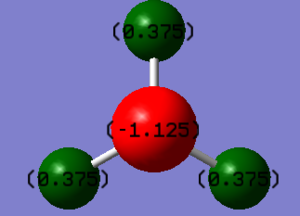
N2 Optimisation
| What is the molecule? | N2 |
| What is the calculation method ? | NH3 |
| What is the basis set? | RB3LYP |
| What is the final energy E(RB3LYP) in atomic units (au)? | -109.52412 |
| What is the RMS gradient? | 0.00000060 |
| What is the point group of your molecule? | D∞H |
| What is the N-H bond distance in Armstrong? | 1.11 |
| What is the N-N angle (°) ? | 180 |
Item Table of N2
Item Value Threshold Converged? Maximum Force 0.000001 0.000450 YES RMS Force 0.000001 0.000300 YES Maximum Displacement 0.000000 0.001800 YES RMS Displacement 0.000000 0.001200 YES
Link to optimization file-https://wiki.ch.ic.ac.uk/wiki/images/9/96/Sameer_Imran_N2_OPT.log
N2_Molecule |
Vibrational analysis of N2
| Wavenumber(cm-1) | 2547 |
|---|---|
| Symmetry | SGG |
| Intensity( arbitrary units) | 0 |
| Image | 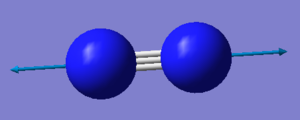 |
Structural Analysis of N2
| How many modes using 3N-5 rule? | 1 |
| which modes are degenerate? | None |
| which modes are "bending" vibrations and which are "bond stretch" vibrations? | Only one mode stretches |
| which mode is highly symmetric? | None |
| Which is the "umbrella" mode ? | None |
| how many bands would you expect to see in an experimental spectrum of N2? | 1 |
Atomic Charges
Atomic charges of both hydrogen atoms are 0 arbitrary unit because they are the same elements and so have the same electronegativity so a dipole is not induced and doesn't appear on the IR spectrum
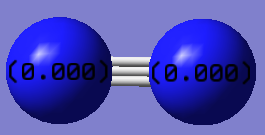
H2 Optimisation
| What is the molecule? | H2 |
| What is the calculation method ? | RB3LYP |
| What is the basis set? | 6-31G(d,p) |
| What is the final energy E(RB3LYP) in atomic units (au)? | -1.17854 |
| What is the RMS gradient? | 0.00012170 |
| What is the point group of your molecule? | D∞H |
| What is the H-H bond distance in Armstrong? | 0.74 |
| What is the H-H angle (°) ? | 180 |
Item table of H2
Item Value Threshold Converged? Maximum Force 0.000211 0.000450 YES RMS Force 0.000211 0.000300 YES Maximum Displacement 0.000278 0.001800 YES RMS Displacement 0.000393 0.001200 YES
Link to H2 optimisation file- https://wiki.ch.ic.ac.uk/wiki/images/8/8d/Sameer_H2.log
H2_Molecule |
Vibrational analysis of H2
| Wavenumber(cm-1) | 4461 |
|---|---|
| Symmetry | SGG |
| Intensity (arbitrary units) | 0 |
| Image | 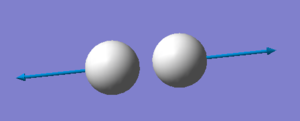 |
| How many modes using 3N-5 rule? | 1 |
| which modes are degenerate? | None |
| which modes are "bending" vibrations and which are "bond stretch" vibrations? | Only one stretches |
| which mode is highly symmetric? | None |
| Which is the "umbrella" mode ? | None |
| how many bands would you expect to see in an experimental spectrum of H2? | 1 band |
Atomic Charges
The atomic charges of both hydrogen atoms 0 because they are the same elements and so have the same electronegativity so doesn't induce a dipole and doesn't appear on the IR spectrum
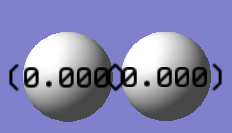
Comparison of N2 and H2bonds with monometallic TM Complexes
N2
| Name of Complex | ((h5-pentamethylcyclopentadienyl)-(1-(pyridin-2-ylmethyl)-3-(2,4,6-trimethylphenyl)-1,3-dihydro-2H-imidazol-2-ylidene)-dinitrogen-iron tetraphenylborate)) |
| Unique identifier code | VEJDIA |
| Link to the structure | https://pubs.acs.org/doi/10.1021/acs.inorgchem.7b01918 |
| N-N bond length of Complex(Armstrong) | 1.10449 |
| N-N bond length normal (Armstrong) | 1.10550 |
The Nitrogen bond length is slightly smaller than the normal diatomic bond length. This is due to the nitrogen atom donating its lone pair of electrons to the Fe+ ion and so the nitrogen atom bonded to Fe+ decreases in electron density and so becomes positively charged. Due to back bonding electrons from the Fe+ orbital are donated to the nitrogen atom to compensate for the loss of electron density (lone pair) and bond length decreases as there's greater overlap of orbitals due to increase in electron density.
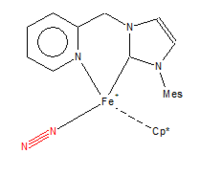
Extra information-H2
| Name of Complex | Hydrogen tripyrazolylborate-N,N',N)-(dihydrogen-H,H')-hydrido-(tri-isopropylphosphine)-ruthenium |
| Unique identifier code | CUJWEK |
| Link to the structure | https://pubs.acs.org/doi/abs/10.1021/om900442m |
| N-N bond length of Complex(Armstrong) | 0.998478 |
| N-N bond length normal (Armstrong) | 0.74309 |
The H-H bond length for the complex is longer than the bond length of the normal diatomic H2 because both hydrogen atoms in the complex are donating electron density to the Ruthenium atom. Therefore the electron density between the hydrogen atoms decreases so less overlap of orbitals and hence bond length increases.
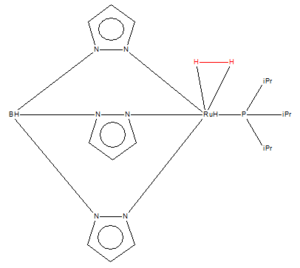
ΔE of Haber Bosch Process
E(NH3)=-56.55777 au
2*E(NH3)=-113.11554 au
E(N2)=-109.52412 au
E(H2)= -1.17854 au
3*E(H2)=-3.53562 au
ΔE=2*E(NH3)-[E(N2)+3*E(H2)]= -0.05580 au
ΔE= -146.5 KJ/mol
The Ammonia is much more stable than the gaseous reactants because the reaction is exothermic so releases energy and therefore the ammonia is at a lower energy state and more stable.
SH2 Optimization
| What is the molecule? | SH2 |
| What is the calculation method ? | RB3LYP |
| What is the basis set? | 6-31G(d,p) |
| What is the final energy E(RB3LYP) in atomic units (au)? | -399.39 |
| What is the RMS gradient? | 0.00012068 |
| What is the point group of your molecule? | C2V |
| What is the S-H bond distance in Armstrong? | 1.35 |
| What is the H-S-H angle (°) ? | 93 |
Item table of SH2
Item Value Threshold Converged? Maximum Force 0.000175 0.000450 YES RMS Force 0.000145 0.000300 YES Maximum Displacement 0.000472 0.001800 YES RMS Displacement 0.000386 0.001200 YES
Link to SH2 optimisation - https://wiki.ch.ic.ac.uk/wiki/images/d/d2/Sameer_SH2.LOG
SH2_Molecule |
Vibrational analysis of SH2
| Wavelength (cm-1) | 1224 | 2692 | 2712 |
|---|---|---|---|
| Symmetry | A1 | A1 | B2 |
| Intensity (arbitrary units) | 5 | 7 | 9 |
| image | 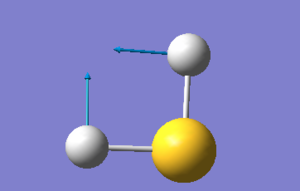 |
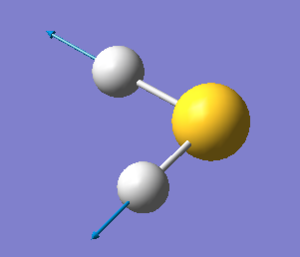 |
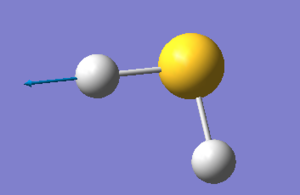 |
Structural Analysis of SH2
| How many modes using 3N-6 rule? | 3 modes |
| which modes are degenerate? | None |
| which modes are "bending" vibrations and which are "bond stretch" vibrations? | Mode 1 is a bending vibration and Modes 2 and 3 are stretching vibrations |
| which mode is highly symmetric? | Modes 1 and 2 |
| Which is the "umbrella" mode ? | None |
| how many bands would you expect to see in an experimental spectrum of SH2? | 3 |
Atomic Charges
The atomic charge of Sulfur atom is -0.312 which is expected because its more electronegative than hydrogen so pulls electrons and so has a higher electron density around it, inducing a negative dipole. The atomic charge of hydrogen is 0.156 which is positve due to the high electronegative nature of Sulfur and so a positive dipole is induced.
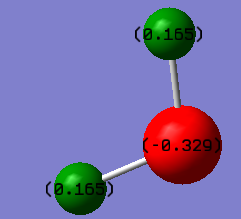
Molecular Orbitals of SH2
Marking
Note: All grades and comments are provisional and subject to change until your grades are officially returned via blackboard. Please do not contact anyone about anything to do with the marking of this lab until you have recieved your grade from blackboard.
Wiki structure and presentation 1/1
Is your wiki page clear and easy to follow, with consistent formatting?
YES
Do you effectively use tables, figures and subheadings to communicate your work?
YES - good structure.
NH3 0.5/1
Have you completed the calculation and given a link to the file?
YES
Have you included summary and item tables in your wiki?
YES
Have you included a 3d jmol file or an image of the finished structure?
YES
Have you included the bond lengths and angles asked for?
YES
Have you included the “display vibrations” table?
YES
Have you added a table to your wiki listing the wavenumber and intensity of each vibration?
YES
Did you do the optional extra of adding images of the vibrations?
YES
Have you included answers to the questions about vibrations and charges in the lab script?
YES - good answers for the charges question and most of the vibration questions.
Due to the low intensity of vibrations 4, 5 and 6 you only see two peaks in the IR spectrum. (You wrote "mode 2" for the answer to this question which doesn't make sense.)
N2 and H2 0/0.5
Have you completed the calculations and included all relevant information? (summary, item table, structural information, jmol image, vibrations and charges)
YES - good explanation of the charges.
However you have given a bond angle of 180 for N2 and H2, there are no bond angles in diatomic molecules. Bond angles involve exactly 3 atoms.
Crystal structure comparison 0/0.5
Have you included a link to a structure from the CCDC that includes a coordinated N2 or H2 molecule?
No you have referenced a paper but not given a link to the CCDC crystal structure.
Have you compared your optimised bond distance to the crystal structure bond distance?
I can't tell as you refer to a "normal" N-N bond length but you don't explain what that is.
Haber-Bosch reaction energy calculation 1/1
Have you correctly calculated the energies asked for? ΔE=2*E(NH3)-[E(N2)+3*E(H2)]
YES
Have you reported your answers to the correct number of decimal places?
YES
Do your energies have the correct +/- sign?
YES
Have you answered the question, Identify which is more stable the gaseous reactants or the ammonia product?
YES
Your choice of small molecule 2.5/5
Have you completed the calculation and included all relevant information?
YES
Have you added information about MOs and charges on atoms?
YES - you have explained the charges well.
However your understanding of the MOs is quite flawed. You have assigned H 1s contributions to all the MOs, when actually only the last 3 have H 1s contributions for example. The 2nd MO pictured is simply the 2p AO on the S atom, it is a non-bonding MO and has no contribution to the bonding of the molecule.
Independence 1/1
If you have finished everything else and have spare time in the lab you could: Check one of your results against the literature, or
YES you looked up an extra crystal structure and explain the change in bond length, well done!
Do an extra calculation on another small molecule, or Do some deeper analysis on your results so far

